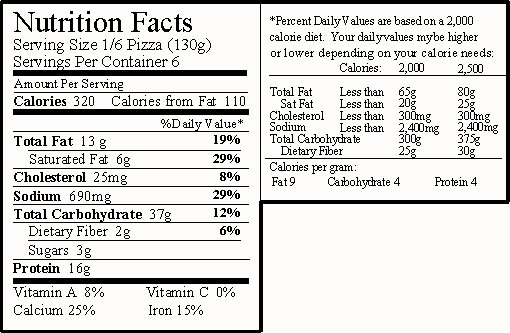
You know that if you don't eat, you won't have an energy! If you don't eat, you just don't feel well! Our bodies need fuel just like a car needs to be filled with gasoline in order to run. We saw in Activity 1 that Fats, Carbohydrate, and Protein supply energy to your body. You decide for dinner that you would like to have one or maybe two pieces of pizza. What fuel are you giving your body? Here is the Nutrition Label from a deep dish pizza. How do we interpret this information?
Note: All of the addition, subtractions, multiplications, and divisions in this investigation should be done by hand. Round your answers. We will use the TI-73 to collect the data in lists so that later, in Activity 3 when we analyze an entire meal, we will not have to do many calculations by hand!

In the Warm Up Activity, you found that the Food and Drug Administration, FDA, has set up guidelines for eating for health. We are going to follow the energy nutrients, fats, carbohydrate, and protein. Notice that there are more categories listed on the label.
| A | B | C | D | E | |
| Pizza (g) | Calories/gram | Pizza Calories | Recommended Daily Calories | Calories Left for the Day | |
| Fat | |||||
| Carbohydrate | |||||
| Protein |
30% - Fat 60% - Carbohydrate 10% - Protein
Using this information fill in column D. Write the math! Write an explanation of how you did the calculations.
Back to the Introduction! |
 |
Margo Lynn Mankus |
 1998 by
Margo Lynn Mankus
1998 by
Margo Lynn Mankus